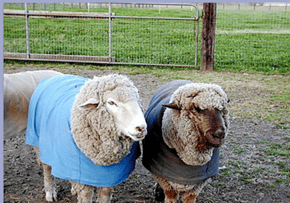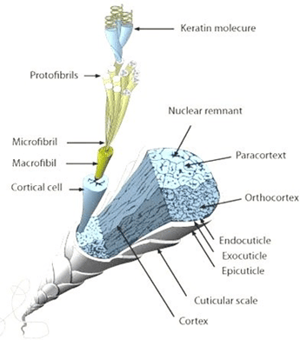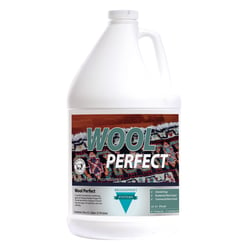Depending upon the market you serve, you may clean wall-to-wall wool carpet about as often as you see a unicorn. Wool is a major part of the market in Australia, New Zealand, England, and some other European markets. However, it accounts for only a fraction of 1% of residential carpets in the USA. It does have a stronger showing in the commercial market. Wool is the fiber of choice for quality area rugs both hand-woven and machine-made.
The self-extinguishing and flame retardant properties of wool make it an excellent choice for safety reasons in hotel lobbies and other carpeted areas where large numbers of people enter and exit a building. Fire codes in some cities and states require these characteristics.
Wool is a protein fiber that comes from the fleece of sheep and lambs (or occasionally goats or some other animals in rugs). This is one of the oldest fibers used by man, dating back over four thousand years. Rugs constructed of wool have been unearthed that date back to around 2000 BC. It is still one of the finest face yarns available for carpets.
Wool’s chemical makeup includes sulfur, which accounts for the wool smell when it is damp. Water vapor attaches to and transports the sulfur molecule to our nose.
Wool fiber is composed of three distinct sections
- The epidermis or cuticle is the tough outer skin consisting of serrated scales that overlap each other. Much of this outer layer is removed in the cleaning and processing of the wool. More of the cuticle may be intentionally removed with harsh chemicals during the finishing of rugs to make the fiber shinier or to give the rug an older appearance by affecting the dyes. These chemicals weaken the fiber.
- Cortex or the spindle-shaped fibrous bulk of the fiber. The twist to this segment of the fiber gives it a spring-like quality and adds to its resilience, allowing wool yarn to stand up well to traffic.
- Medulla or core of the fiber through which the fiber once received nourishment.

Wool fibers are all staples, that are of a short length as opposed to long continuous filaments. Strands of wool are graded by the length of the fiber, the longer the better, and by the coarseness or fineness of the fiber which is largely determined by the diameter of the fiber.
The shortest, lowest quality fibers are termed linters 2” or 3” long. The short length of the fiber prevents them from being as thoroughly spun into the yarn. They can more easily be pulled loose and create fuzzing or loss of fiber. Most carpet and rugs are made from the medium-length fibers 4” to 6” long. These are usually thicker or coarser fibers. Longer high-quality fibers are called worsted wool and are most often used for clothing.
The strength of the fiber is another factor in the quality of the wool. If purchasing a wool rug or carpet, you may wish to pull loose a few fibers to examine the length and also tug on the ends of a fiber a few times and see how well it resists breaking. Strands that break easily will not hold up to traffic as well.
PROS
- Hides Soil - Wool has excellent soil hiding capabilities. Wool will not exhibit or show soil as much as other fibers. Wool is an opaque fiber (as opposed to synthetics which are translucent) that does not allow soil from the other side to show through. In addition, wool doesn’t refract and reflect light like synthetics. The naturally dull appearance and scaly nature of the epidermis hide soil.
- Resilient - Wool is very strong, elastic, and resilient. Wool face yarn in a well-constructed carpet will stand up to the heaviest traffic and still look beautiful. (Notice the carpet in many finer hotel lobbies and hallways and in casinos.)
- Natural Crimp - Natural crimp makes wool an excellent insulator and adds to its superior resiliency.
- Good Absorbency - This means that wool readily accepts a number of dye types and techniques. Keep in mind, this means easy staining and slower drying also.
- Soil Release - Wool responds very well to cleaning as moisture makes the fiber swell and releases particle soil.
CONS
- Expensive - This arises mainly from the processing cost, the cleaning, the preparation, etc., rather than the actual cost of the raw material.
- Fiber Distortion - Wool is very prone to distortion by excess agitations such as jet streaks and wand marks. This is particularly pronounced when cleaning with very hot water. To help prevent this kind of distortion the cleaner should turn the temperature down somewhat on a wool cut pile carpet and be sure that the grooming takes place quickly after the rinse step.
- Stains Easily - Due to its absorbency and ease of dyeing, wool is also easily stained by wine, Kool-aid®, and other acid dyestuffs. Wool accepts acid dyes at dye sites similar to nylon fibers. Both fibers benefit greatly from the acid dye resistors added to some industry protectors. Remember that absorbency is the same quality that makes wool so desirable as far as dye acceptance and obtaining the beautiful rich colors that can be found in wool carpets and Oriental rugs.
- Chemical Sensitivity - Wool is sensitive to excessive alkalinity such as high pH and buffered alkaline cleaning agents, especially with prolonged exposure. This exposure will tend to make wool brittle and somewhat discolored. Some of the epidermis may be lost. This shortens the useful life of the carpet. When excessive, this problem is referred to as “felting”. Aggressive agitation can aggravate felting. Following cleaning, wool fibers should be left at a pH between 4.5 and 7.0.
- Fuzzing - Remember that fuzzing can be a source of problems because wool only comes as a staple yarn and excess agitation can cause that fuzzing effect.
by Scott Warrington
Featured Products

Bridgepoint Systems Wool Cleaning Wool Perfect Rug and Fabric Preconditioner, 1 Gallon
